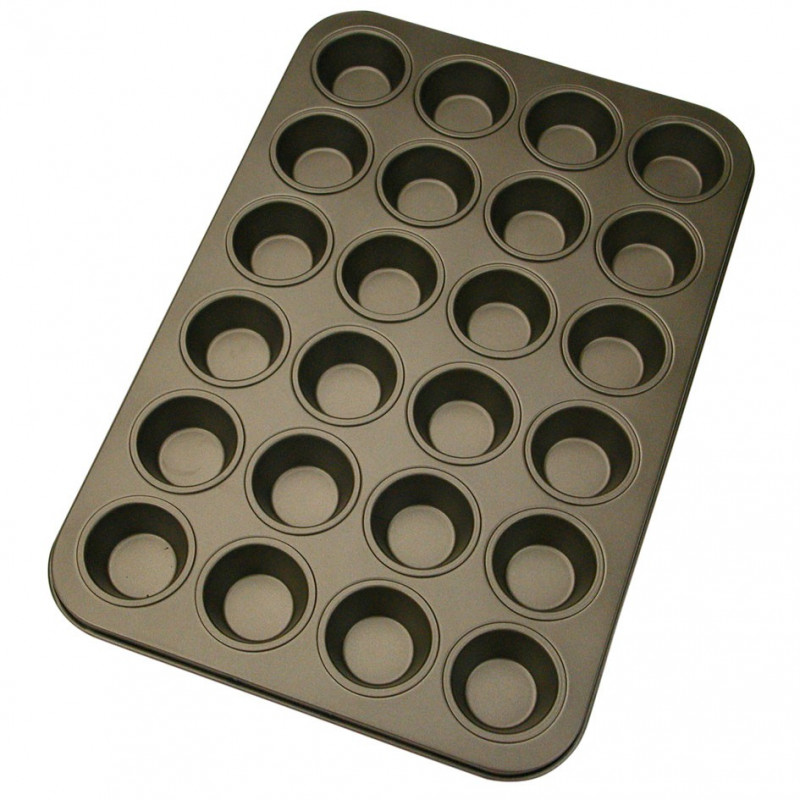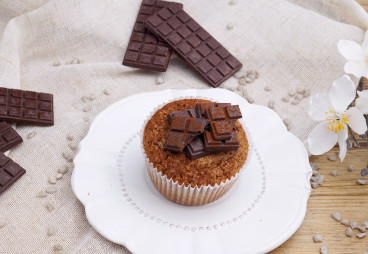

Order by 4 pm = delivery the next working day.
From CHF 100 purchase


This baking pan is suitable to bake 24 mini CupCakes at the same time. The cups ideal to bake cupcakes or muffins with a diameter of 5 cm. The cupcake baking pan is a great help when it comes to shape the little treats. In small paper cups, the dough is placed in the mold, which moves into the oven and soon the kitchen smells of the sweet little cakes.
Data sheet
Enjoyed plain, elegantly decorated or with colorful fondant coatings and shapes, cupcakes are irresistible. To ensure that their appearance is just as good as their taste, you need a good cupcake baking pan.
200 g butter
180 g sugar
4 tsp vanilla sugar
4 tsp grated orange peel
4 tsp grated lemon zest
1 pinch salt
3 eggs
200 g flour
3 tbsp cornstarch
1 tsp baking powder
120 ml orange juice
2 tbsp lemon juice
2 tbsp sugar
Beat the butter until smooth, then add the sugar, vanilla sugar, orange and lemon zest, salt and the egg and mix to a homogeneous dough. Now sift in the flour, cornstarch and baking powder and fold in. Put a nice paper cup in each well of the baking pan and fill it 2/3 with batter. Bake at 160° (hot air) or 180° (top and bottom heat) for 20 to 25 minutes. Remove the baked cupcakes from the pan and let them cool on a wire rack. If you have more batter, you can bake a second tray at the same time. Mix the orange juice well with the lemon juice and sugar. Then pour the liquid over the cupcakes or brush it on.
Now it's time to decorate. A sweet topping of frosting, whipped cream or buttercream refines the noble little cakes. Sweet patterns, figures or animals can also be conjured up on the cupcakes. With a little fondant, Massa Ticino or marzipan, this is very easy.
At children's birthday parties, decorating your own delicious cupcake always creates a buzz. With various decorating materials, sugar beads and toppings, every children's party becomes a hit.
As simple as cupcakes are made, they are delicious. Experiment and try different recipes and find your favorite cupcake!
The cupcake is the small counterpart to the impressive cake. Sweet and irresistible! And its production is not at all as elaborate as the impressive appearance suggests.
Then you should apply for our Cupcake course log in. Here you can let your creativity run free and get inspired by other baking enthusiasts. Cupcakes are sweet little cakes, but you want to try something new? Then you will like our Course offer love. Come and visit us! We are looking forward to you.
A cupcake literally means "cup cake" and is a cup that is baked in a cup-sized baking pan. This is not just a cute idea, but is based on fact. The dough was actually baked in a cup at that time by the US American Amelia Simmons in 1796. This is how the cupcake came into being. Today, there are many different baking cups that replace the cup. After baking, the cupcakes are elaborately decorated. For this purpose, different textures and foods are used. The little cupcake not only looks sweet, but also tastes like it. Thus, the cupcakes are the little siblings of cakes.
A muffin is a small cake and, however, is not decorated with a topping. The muffin is usually rather plain, compact and rises during baking. The muffin is thus a small cake and not as sweet as a cupcake. The origin is rather unclear, but it is believed that the muffin comes from the French-speaking world and was derived from moufflet (soft bread). A Low German word origin is also not excluded. Therefore, the muffin could be derived from the so-called Muffen pastry.
 Chocolate cupcakes recipe
Chocolate cupcakes recipe
 Carrot cupcakes
Carrot cupcakes

This baking pan is suitable to bake 24 mini CupCakes at the same time. The cups ideal to bake cupcakes or muffins with a diameter of 5 cm. The cupcake baking pan is a great help when it comes to shape the little treats. In small paper cups, the dough is placed in the mold, which moves into the oven and soon the kitchen smells of the sweet little cakes.